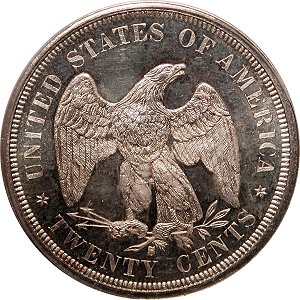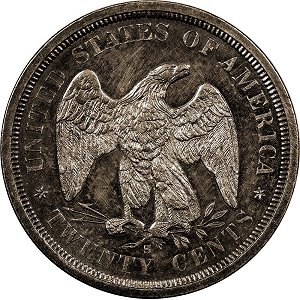

Introduction
The rare 1875-S Branch Mint Proof (BMP) twenty-cent piece has always been controversial. Assumed to
have been made to commemorate the first striking of this new denomination in the region of the country
where the "demand" for the coin was supposedly highest, fewer than 10 of these truly special coins are
known.
The two primary reasons for controversy are the lack of mintage records from the San Francisco mint
about the proofs (or any documentation for that matter), and the fact that the obverse and reverse dies for
these coins were also used to produce ordinary circulation or business strikes. Quality does vary among
these coins. The finest known example, currently PCGS PR64 CAM BM (Branch Mint), is likely the Roy
Rauch coin, the discovery piece. Two others are graded PR63, one each by PCGS and NGC. A few other
impaired coins are known. The die diagnostics have been well documented, both by Walter Breen in his
Complete Encyclopedia, and his Encyclopedia of U.S. Proof Coins. The diagnostics were also documented in the First Edition of this book.
Making matters more confusing is that there are some very well-struck circulation strikes from this documented die pair
that are somewhat proof-like. However, most would agree there is a significant difference between the
proofs and a circulation strike, even an exceptionally well-struck proof-like coin. Putting one of the proofs
next to the best of the circulation issues makes it no contest.
Walter Breen listed a mintage of 12, but that is little more than speculation on his part based on the num
ber of pieces known to him. With about 7-9 known, a mintage of 10-15 seems reasonable, and thus the
claim of 12 might be in the right ballpark.
Two die pairs!
Controversy turned more into mystery when, in 2022, it was discovered there were actually two different
reverse dies used for these special pieces. Examining the finest known example, (PCGS PR64 CAM BM, CAC),
it was discovered that it was made from a different reverse die, one not seen on the well-documented
proofs, or on any circulation strikes.
How could this have happened?
The authors believe that to commemorate the striking of the new denomination, a few (perhaps 2 or 3?)
coins were struck as full Proofs in San Francisco, being the equal of Philadelphia Proofs in every respect.
The die polishing of the reverse die (in preparation for striking) separated or blunted some of the serifs of
the letters in the legend, and also polished out some of the feathers on either side of the eagle's breast.
We also theorize that at some point later, some mint staff decided that a few more proofs were desired,
perhaps for themselves? So, they picked a pair of dies off the shelf, including (perhaps purely by coincidence) the original obverse die. They polished the daylights out of a different reverse die, grinding away
some of the details on the lower right, separating the serifs from TS in CENTS, also resulting in diagonal
die scratch and separated leaves from the stems. Perhaps 5 to 10 of these were made? On most of these
second-strike coins, the obverse is slightly more reflective and mirrored than the reverse, and thus they fall
slightly below the quality of what would be considered a full proof. But they are definitely not typical circulation issues, not even proof-like ones.
At some point afterwards, this particular die pair was used to strike normal circulation issues, some of
which are proof-like, including some well-struck coins.
Some have doubted the existence of the Branch Mint Proofs in their entirety, claiming that they are simply
proof-like circulation strikes. This is based heavily on the argument that the same dies were used for the
"so-called proofs" and circulation strikes, and where does one draw the line between the so-called proofs
and the proof-like coins?
Because the newly-documented reverse die on the finest of these coins appears to be a proof-only die, that
part of the controversy is eliminated for those struck by that die pair. However, side-by-side comparison
of the second-strike proofs shows a stark contrast between them and well-struck proof-like circulation
strikes.
Terminology
What to call these coins? We are proposing the following terms for these coins.
We believe the coins with the new proof-only reverse, clearly the most well-made and essentially equal in quality to
Philadelphia proofs, should be called Branch Mint Proofs and labelled as Proofs. They are almost certainly the first double dimes struck in San Francisco and are unlike any others and are in a class by themselves.
Because the few remaining examples with the traditional, well documented, branch mint proof reverse die
are clearly above the quality of the best of the circulation issues from the same die pair, we suggest that the
term Specimen or Special Strike is appropriate for these second-run coins.
Important Attribution Change from the First Edition
In the First Edition of this book, the sole listing for the Branch Mint Proof was attributed as 1875-S
BF-BMP-1. This is the only attribution from the First Edition that will change in the Second Edition (this
book). The full proof, using the proof-only reverse, will now be designated as 1875-S BF-BMP-1. The
second-run special strikes, with the traditional branch mint proof reverse, will be attributed as 1875-S BF-SP-2.
 |
 | |
 |
 | |
Die characteristics for each are described on the following pages.
